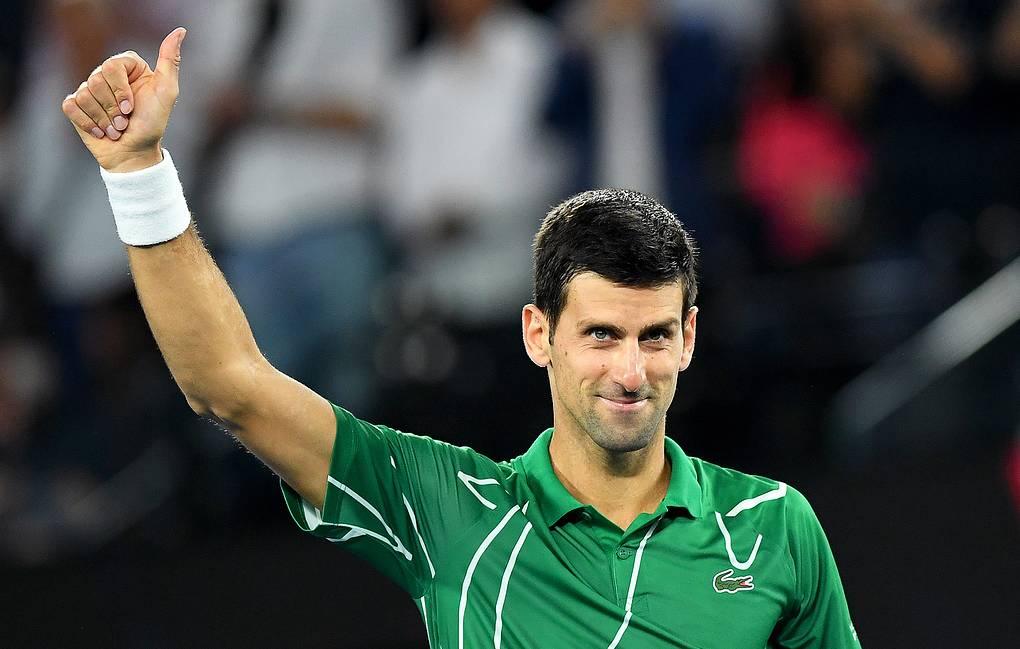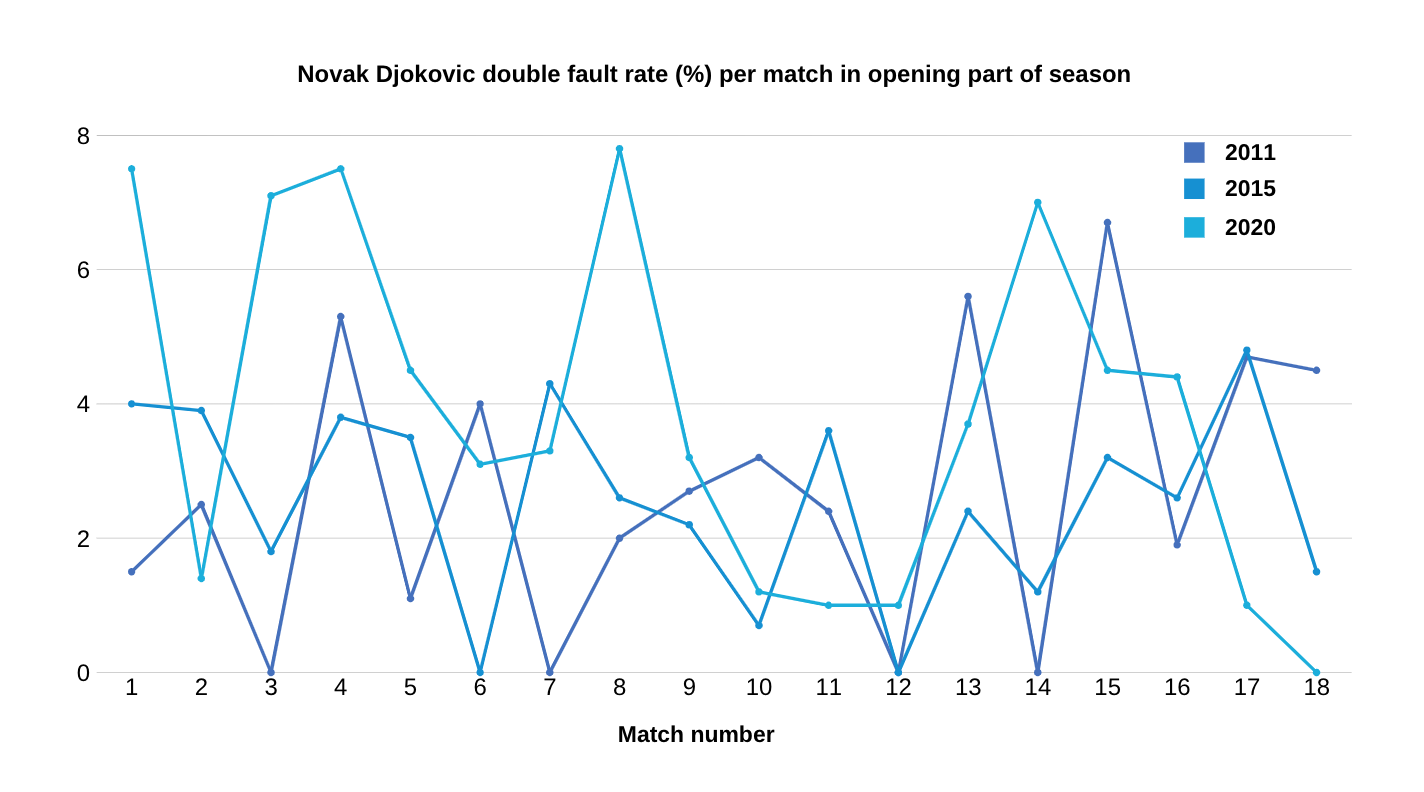
March 20, 2020
With the tennis season being suspended till at least 7 June, Novak Djokovic will enter the second week of June still unbeaten for the year for the first time in his career. In 2011, Djokovic lost his first match of the year on 3 June at the French Open against Roger Federer. The situation this year is unprecedented and while there are far more important things to think about, it is perhaps a good distraction to look back at how spectacular Djokovic’s start to this year was.
Since the start of the last decade, it was always thought that Djokovic would start a tennis season well. Hard courts are his most favoured surface and the Australian Open is where he won his first major title in 2008. The first Grand Slam tournament is followed by a schedule for Djokovic which usually involves the Dubai Open, and then the two ATP World Tour 1000s tournaments at Indian Wells and Miami. These tournaments have been very productive for the Serbian but three years of his career stand out for an incredible start.
Djokovic in 2011 had statistically the best start to a men’s tennis season since John McEnroe in 1984 as he won 41 consecutive matches. 2015 was also a stellar year for the world number one and ended as perhaps his most satisfying, because he was just one match away from winning all four majors in the same calendar year. We can now add 2020 to that list and even though he will not have the clay season to fully show whether he is at his dominant best everywhere, he has shown himself to be the best in the world again.
A question which is worth looking at is whether there are any trends and patterns that can be seen when analysing these three years in isolation. Did Djokovic do anything particular in these years to have those stunning starts, or was each year in a way its own universe? Did he show any particular improvements and how does this year’s start compare to the other two?
The sample size for this analysis is every match that Djokovic has played till the end of the Indian Wells tournament for the three years mentioned. With this year not having an edition of Indian Wells, we will look at Djokovic’s matches till the end of the Dubai Open. That means we are looking at the first 18 matches Djokovic played in 2011, the first 20 matches he played in 2015 and the first 18 matches he has played this year. This makes for a relatively even sample space and gives us the chance to play the comparison game which I love.
First, let us look at the year 2011. Both 2009 and 2010 were years of transition for Djokovic as he looked to become an established member of the “Big Four” of him, Federer, Rafael Nadal and Andy Murray. After winning the Australian Open as a 20-year-old, he struggled to replicate that type of performance consistently for a few years because of issues in his game, particularly his serve.
Everyone knows he was being ridiculed during the 2009 season at times because of his service motion, which made it look like he was almost bowling the ball in. Djokovic’s double fault percentage during the 2010 season was a staggering 4.8%, which remains the highest for a year in his career. It is well documented how both his change to a gluten-free diet and his part in Serbia’s victory in the 2010 Davis Cup played a huge role in his historic 2011 season. But an underrated aspect of his success was the new found solidity in his serve.
He dropped his double fault rate to an average of 2.67% during the first 18 matches of his 2011 season and upped his first serve points won by almost seven percent compared to 2010. In almost every statistic concerning his serve, Djokovic improved by a significant margin compared to his 2010 season. Not only did this help him while serving, it also seemed to free up his return game which was always his strong suit. But no one could have imagined the level of returning he would show in 2011 and ever since.

The now trademark rubber band-like return caused havoc for players on the tour and especially his two biggest rivals in Nadal and Federer. He won a preposterous 47.86% of return points he played until the end of Indian Wells that year and converted almost 62% of all break points he had up until that point of the year. On countless occasions, a perfect serve would be returned to the opponent’s shoe tops by Djokovic and the opponent would literally stand still. They would not know what to do and have practically not known what to do since.
Before getting into the statistics of Djokovic’s 2015 season, I think it is important to note how important the 2014 season was for the Serbian. Heading into Wimbledon 2014, Djokovic had six major titles which was great in itself. But the fear factor he had developed in 2011 was slowly diminishing. He had lost five of his last six Grand Slam finals and was perhaps the underdog ahead of the final against Federer in SW19 because of his mental strength.
Somehow he withstood a barrage from Federer towards the end of the match to win in five sets and win what is probably the most important major of his career. Since then in 13 major finals, Djokovic has won 11 titles and lost just twice to Stan Wawrinka in Paris and New York. That streak started in Wimbledon six years ago, but it has seen no better peak than in his 2015 season.
When comparing just the statistics between the three years aforementioned, 2015 is actually the year which is least impressive. The only number that stands out is the percentage of points he won on his second serve until the end of Indian Wells, which was 61.72% and much more than the other two years. He also lost twice up until the end of Indian Wells, in the quarter-final of Doha and the final in Dubai.
But, to the eyes of people who have watched the majority of his career, many will agree that Djokovic was in the best headspace he has ever been in his life on the tennis court. Nothing seemed to phase him, least of all the crowd. The famous outburst against the New York crowd after his match versus Andy Roddick at the US Open in 2008 seemed like a lifetime ago. The best example of this came near the end of the year against Federer in New York. The crowd was vociferous in their support of the Swiss and cheered many an error from Djokovic. But once again, the Serbian shut out all the noise to win, in my eyes, in the most impressive fashion in his career. The pure statistics do not really show how good Djokovic was in 2015, because so much of it was in the mind.
Before Wimbledon in 2013, several top players took part in a fun quiz on the Wimbledon YouTube channel about their career so far. When asked how many aces he had hit in his whole professional career, his response was: “I would say maybe 1,500.” He was off by 1,750 and he later said: “I’m not a great server but I underestimated myself.” Not only has he underestimated himself, but the majority of the public has as well.
In the 18 matches he has played so far in 2020, his ace rate is the highest it has ever been in his career at 9.87%. This is not only helping Djokovic to win more points on his serve, but also save more of the break points he is facing. This year he has saved almost 70% of the break points he has faced. An interesting thing to note however is that on average, he is spending more time on court per match in this beginning part of the year. He is averaging one hour and 59 minutes per match in 2020, compared to an hour and 47 minutes in 2011 and 2015.
What will happen with Djokovic’s form and how long the unbeaten run will last once tennis returns will be fascinating to watch. More fascinating will be the type of game style Djokovic will employ on the grass and the hard courts. These courts are more conducive to attacking match play but whether he will follow the trend of players being less defensive as they get older will also play a big part in his success this year. But this year can well and truly be added to the greatest starts in the Djokovic highlights reel, and all the signs lead to him continuing in this fashion for a while.